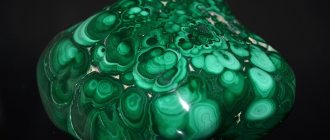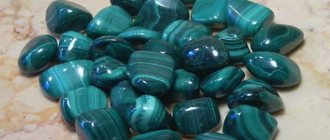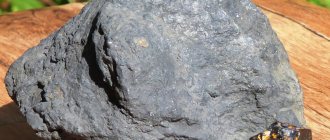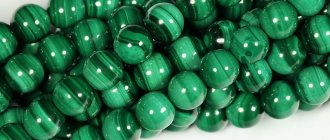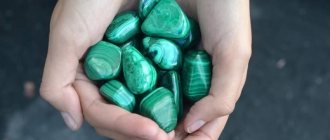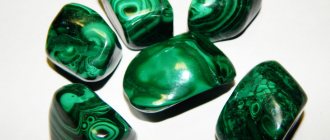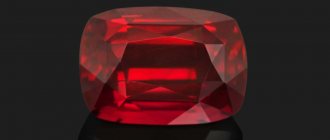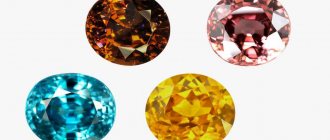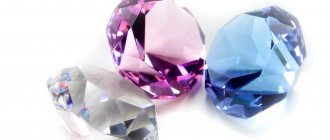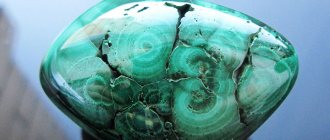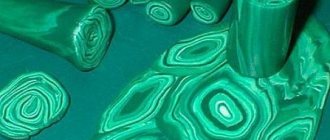This article will focus on malachite. All people who are interested in stones are familiar with this beautiful green mineral. We will talk about the main properties of this mineral, its use and, of course, about the imitations of malachite that are now literally flooding the market.
About the mineral Malachite scientifically
- Color: light green, emerald, black green.
- Chemical formula: Cu2(0H)2[C03], basic copper carbonate.
- Hardness: 3.5-4.
- Degree of transparency: opaque.
- Density: 3.75-3.95.
- Light refraction: 1.656-1.909.
- Cleavage: perfect.
- Birefringence: -0.254.
- Fracture: shell-like, splintered.
- Variance: none.
- Syngony: monoclinic.
- Pleochroism: strong - from colorless to green..
- Crystals: small, long prismatic; usually buds and cluster-shaped discharge, fine needle-like aggregates.
- Absorption spectrum: not interpreted.
- Luminescence: absent.
The name was probably given for its green color, reminiscent of the color of mallow leaves (Greek malache - mallow), or for the low hardness of the mineral (Greek malakos - soft). The polished surface of malachite reveals a pattern of alternating light and dark concentric rings, straight stripes, or a pattern of a more complex configuration due to the concentric structure of the aggregates. More or less monochromatic pieces are rare. Sometimes malachite forms close intergrowths with azurite - azure-malachite, less often - with turquoise and chrysocolla.
Samples of natural malachite.
Malachite aggregates consist of tiny crystals. Large crystals are very rare and are highly prized by collectors. Untreated malachite has a weak glassy luster, but when freshly broken and polished, its luster is often silky. Malachite is sensitive to heat and unstable to acids, ammonia, and is also destroyed in hot water. The mineral is usually represented by buds, cluster-shaped, pineal-shaped, stalactite-like secretions, and less often - flat crusts. It occurs when carbonate rocks are exposed to copper-containing solutions in the immediate vicinity of copper deposits and in the zone of their oxidation. The most famous malachite deposits in the Soviet Union were previously in the Urals near Sverdlovsk. It was here that malachite was mined for cladding fireplaces, tabletops, pilasters and vases in the Malachite Hall of the Winter Palace, as well as the columns of St. Isaac's Cathedral in Leningrad.
This is how unusual malachite can be.
Nowadays the main supplier of malachite to the world market is Zaire (Kolwezi). Malachite is partly processed on site and partly supplied to the market in raw form. In addition, there are malachite deposits in Australia, Chile, Zimbabwe, Namibia, the USA (Arizona) and the USSR (Urals, Kazakhstan). Malachite, as an elegant stone for decoration and as an amulet supposedly bringing health, was known in Ancient Egypt, Greece and Rome. It was even used for eyeliner (in powder form). In the Middle Ages, malachite was known as a reliable remedy that protected children from witches and other dangers, and was also used as a medicine; Powdered malachite was also used to make green paint. Despite its low hardness and instability, malachite is still one of the most popular jewelry and decorative stones today. It is polished into cabochons or slightly convex tablets; beads are made from it, as well as small cabinet decorations - boxes or stands for candlesticks, watches, ashtrays and small figurines. When processing malachite, they try to maximize the decorative qualities of the stone. Particularly prized is “ocular” malachite with thin concentric rings – “peacock eye”. In large ores, malachite cannot be confused with anything; in small pieces, where banding is not visible, it looks like many opaque green stones.
(Source: V. Schumann “The World of Stone. Precious and ornamental stones.” Publishing house “Mir” 1986)
Natural malachite in beads and cabochons.
Malachite deposits. Present day.
Today, the largest deposits of malachite are located in Africa. Previously, this mineral was mined in Russia, but now its reserves have been exhausted. Although according to G.N. Vertushkov in the Urals, the discovery of new deposits is possible. In the CIS, malachite is found in Kazakhstan. But the main supplier of malachite to our market is, of course, Africa.
A little about malachite prices
As we already wrote above, almost all the malachite that is now sold in Russian and Ukrainian stores comes from Africa. In fact, malachite from Africa most often ends up on our market in the following way:
- Malachite is mined in Africa and then processed in India. In this case, the cutting and sizing of the beads is of high quality. Accordingly, the price of such malachite cannot be low.
- Malachite is mined in Africa and processed in China. The cut and calibration are worse. Moreover, in our practice we have encountered poorly polished beads without a glossy surface, which can be confused with imitation if there is a lack of experience. The price of such malachite will be lower than that processed in India.
Today, malachite is one of the most frequently counterfeited stones. We will tell you about all the imitations and fakes that we have encountered on the Russian market.
Let's get started:
1. Green striped plastic. You will understand how to distinguish this plastic from malachite by looking at our selection with photographs. Of course, in rare cases you may not be able to distinguish plastic from a real stone, but still, when purchasing a malachite product, you will already be able to distinguish most imitations.
"Malachite" made of polymer clay.
A similar “stone” called “calcilica” was recently “discovered” somewhere in America, for a long time misleading not only ordinary buyers, but also geologists. In fact, it is dried car paint, which is also sometimes called Fordite. According to one version, this method of making money from recycled materials was invented in Detroit.
Malachite is made from plastic, now created on an industrial scale.
Some sellers claim that this is supposedly pressed malachite, but this is not so. If such beads are painted turquoise, then they can be passed off as chrysocolla or turquoise, if black and white, then as agate, and so on.
On the left is a plastic imitation of malachite, on the right are figures made of natural malachite.
You can see pressed malachite in the following photographs. As you can see, these are compressed small pieces of natural malachite, additionally filled with a hardening composition.
Pressed malachite.
2. But with pseudomalachite it’s already more difficult! But more interesting. Pseudomalachite was first discovered by Hausmann in 1813. It got its name because of its sometimes striking similarity to malachite, from which in most cases it differs in a bluer hue. It is a relatively rare mineral found in near-surface oxidation zones of copper ore deposits in associations with malachite, quartz, chrysocolla and limonite.
In the photo: on the left - pseudomalachite (Russia, Middle Urals, Svedlovsk region, Nizhny Tagil), on the right - malachite (Russia, Middle Urals, Svedlovsk region, Nizhny Tagil). The chemical formulas of these minerals are somewhat similar: pseudomalachite - Cu5(PO4)2 (OH)4, malachite - Cu2CO3(OH)2.
Synonyms for this mineral: tagilite, phosphorochalcite, dihydrite, elite or even lunnite. Now all these names except the first are outdated and are not used. Below you can see photos of pseudomalachite. As you can see, it is quite difficult to distinguish malachite from pseudomyalachite from just one photo.
Pseudomalachite from various deposits.
If you have a stone on your hands and you doubt that it is real malachite, you can check the stone by the color of the line. To do this, however, you will have to ruin one bead. The color of the malachite line will be green - from light turquoise to very dark green. The color of the pseudomalachite streak will always be lighter than the stone itself. In addition, the fracture in malachite will be shell-like and splintered, while in pseudomalachite it will be conchoidal. These are such meager methods of verification. The only good news is that if you bought pseudomalachite instead of malachite, then what you will have on your hands is not some kind of plastic, but a beautiful and rather rare stone.
In our next articles we will tell you about stones such as aventurine, agate, variscite, howlite, cacholong, quartz, lapis lazuli, rhodochrosite, charoite and so on. In addition, we will devote a separate article to methods of processing stones and synthetic minerals.
Sources of information: V. Schumann “The World of Stone. Precious and semi-precious stones”, volume 2, mineralogical base “Mindat”, as well as our own experience and the Internet.
Depletion of natural malachite deposits
Malachite initially could not be called a rare stone. However, the constant high demand for the gem led to the fact that numerous deposits were practically depleted, imitations poured into the market and the question of how to distinguish a fake from malachite began to arise more and more often.
At the moment, almost all places where stone is mined are concentrated in Africa, or more precisely in the Democratic Republic of the Congo (formerly Zaire), although previously it was actively mined in Russia, the CIS countries, and Western Europe.
In Soviet times, the Urals, Altai, and Kazakhstan were famous for their mining. But today the most famous mines of that time, in particular, in Nizhny Tagil (Mednorudyanskoye) and in Polevsky (Gumeshevskoye) are completely exhausted and do not function.
African malachite, which is the majority of the source of gem jewelry on the market today, has a number of notable features. Unlike stones previously mined in Russia, it has a larger, more regular and pronounced pattern of concentric rings. This reason, in particular, often causes problems in determining the authenticity of malachite among seasoned connoisseurs who are accustomed to the fact that a natural mineral should have an irregular, complex pattern.
Application
The coil is used in industry, jewelry, and arts and crafts.
Due to its high fire resistance, it is used in new technological developments, as well as in the creation of heat-resistant material (chrysolite-asbestos), from which equipment is made for workers in hot shops, employees of the Ministry of Emergency Situations and firefighters.
The crushed mineral is used in baths and placed in aquariums.
Decorative types are used for cladding panels, facades, fireplaces, and swimming pools.
Ornamental specimens - material for monuments, tabletops, watches, souvenirs, etc.
Jewelry is made from high-quality noble samples with patterns, shine, and glow.
Variants of fakes of natural malachite
Counterfeiting natural malachite is not always an attempt to deceive. Due to the fact that stone jewelry always looks especially impressive and many people want to become the owner of an eccentric pendant or decorative item, imitation is still often just a need to satisfy demand and provide an opportunity to make a purchase on a limited budget.
In other words, in most cases the seller does not hide the fact that he is offering a fake, and the options for artificial products can be as follows:
- Malachite chips. The best option is, in fact, a very low-grade original. In this case, waste is used to create jewelry - small crumbs that are formed when making a product from a real large gem. The crumbs are glued together using epoxy resin and pressed in a special way. In fact, it is difficult to say unambiguously whether it is correct to call products made from crumbs fakes, since in this case the master still works with a real mineral, which has all the magical properties of the original, and, nevertheless, in the harsh rules of the jewelry world, such products are always in a controversial place.
- Synthetic gem. This is, in general, another controversial imitation. The synthetic gem is grown in laboratory conditions. It has the same chemical formula as a natural mineral and is indistinguishable in appearance, but since it is grown “in vitro”, it does not possess the magic of a natural stone.
- Imitation. In this case, we are talking about a clear counterfeit that has nothing to do with malachite. For counterfeiting, a stone of a different type is used; it is simply painted with a malachite pattern and coated with a protective varnish.
- Glass and plastic. They can paint not only another breed, but also glass or plastic. These are the lowest-grade fakes, which will not be difficult for anyone to distinguish, at least by weight. Glass and plastic feel completely different in your hands than stone.
All types of counterfeits of a natural product should cost less than the original. So a low price is one of the ways to distinguish malachite from a fake. However, problems begin when the seller is unscrupulous and tries to deceive - pass off the imitation as a natural gem and sell it for a high price.
What does a coil look like and what are its names?
This stone has a very memorable color: the color is bright green (sometimes there are yellow shades), and the pattern of veins resembles snake skin.
It is sometimes confused with malachite, but there are significant differences between them:
- the coil structure is opaque;
- fibers and leaf patterns are visible;
- special shade;
- the price is lower than that of malachite.
Some specimens resemble jade in appearance, but are inferior to it in physical and chemical properties, in particular in hardness.
Because of the unique color, such an interesting name for the mineral appeared in the Urals. It is also called Ural stone, moss stone, toligor, mountain flax, tow, Korean (or new) jade, apothecary stone.
The color of the serpentine was the reason for its scientific name - serpentine (“serpens” from Latin - snake). Sometimes it is identified with serpentinite, but these are different concepts:
- Serpentinite is a rock containing ornamental and semi-precious minerals.
- Serpentine is an ornamental stone.
Now the name “serpentine” for the mineral is considered obsolete and scientists assigned this term to the rock (serpentinite).
How to check malachite for authenticity
With careful inspection and a few simple experiments, determining the authenticity of a stone is not that difficult. Let's look at how to distinguish real malachite from a fake:
- Weight. First of all, we evaluate the weight. At this stage, the lowest-grade fakes - those made of plastic and glass - will be eliminated by themselves. It is worth noting that malachite is also heavier than many other stones, such as quartz, which is often used to create its imitation.
- Dullness. A real mineral is opaque, matte, its shine is barely noticeable, noble. If the mineral sparkles brightly with gloss or is transparent in light, it is certainly a fake.
- Heterogeneity. Despite the fact that the African rock, as we said above, has a regular pattern, no two identical stones exist in nature. This means that the answer to the question of how to check malachite for authenticity often lies in examining samples sold nearby. If they all look the same, you are looking at fakes; in the same case, when each gem is unique, most likely you are seeing originals.
- Shades. Heterogeneity should be expressed not only in the pattern, but also in color. When counterfeiting, the master, of course, uses several shades of paint, but, as a rule, no more than 3-4; nature creates a much more intricate play of color. It is noteworthy that they often try to pass off malachite as a coil. This is a natural breed, but less valuable. In order to identify these two minerals, you just need to carefully study the types of stones before purchasing. The obvious difference between malachite and serpentine is the shade of green; in the first case it is deep emerald, in the second it is closer to swamp.
- Test for ammonia and acids. If you have carried out an inspection, but still doubt the authenticity, and the seller insists on the naturalness of the stone, you can conduct two experiments, with the condition that if the mineral passes the test, you will definitely purchase it. These tests will slightly modify the stone, and therefore they should be carried out in an inconspicuous place, if we are talking about decoration - from its back. So, how to test malachite. The first test is to drop a drop of ammonia onto the mineral, wait a little, if this is the original, a section of the stone will turn pale and the drop itself will turn blue. The color change does not occur instantly, since natural gems are also coated with a protective varnish. The second test is acids. To make the acid, simply squeeze some lemon juice into a glass of warm water. Apply a drop of the solution to the gem; bubbles should appear on the surface, again, not immediately, if coated with varnish.
Please note that a synthetic mineral grown in a laboratory will withstand any test of authenticity. It is identical to natural in its chemical formula, physical properties and has a unique pattern. This means that there is no exact answer to the question of how to distinguish natural malachite from artificial malachite from the laboratory. In this case, the only guarantor of the authenticity of the stone is the integrity of the seller.
Well, now you know why the mineral is counterfeited today and how to distinguish malachite from an imitation. We really hope that the information provided will be helpful and useful to you. Don't forget to share it with your friends on social networks, perhaps they are planning to buy this beautiful stone right now.
Team LyubiKamni
Origin and physicochemical characteristics
The scientific name of serpentine is serpentine. This is a group of minerals that are layered magnesium silicates with impurities. They do not form crystals; they are a dense mass. These stones are products of rock metamorphism.
Chemical formula: X2-3Si2O5(OH)4, where X=Mg, Fe2+,Fe3+, Ni, Al, Zn, Mn.
Description of serpentines:
- The colors and patterns of minerals depend on impurities. The green range is quite wide - from pale to dark green. Sometimes the tones are yellowish, gray, brown and almost black. Occasionally there are blue and bluish-green shades.
- The luster of minerals is glassy, waxy, and greasy.
- Opaque, translucent at the edges.
- Hardness is below average - 2.5-4.
- Density - 2.2-2.9 g/cm3.
- There is no cleavage.
- The fracture is conchoidal.
- The fire resistance of serpentine is very high; it can withstand temperatures up to 600 °C.
Where did Russian Malachite go? Why do you now have to buy it in Africa?
Columns, floor vases, fireplaces made of Ural malachite - all these beauties are a thing of the past.
Previously, road potholes were filled with malachite chips. Now the leader in production is not Russia, but the Republic of Congo. The African mineral is significantly inferior in quality to the Russian one. Rotunda, fireplace and malachite bowl. Hermitage Museum. SP-b
Rotunda, fireplace and malachite bowl. Hermitage Museum. SP-b
Malachite - copper carbonate - has been known since ancient times. A beautiful greenish mineral occurs in copper mines. Earrings, beads, and necklaces were made from it. Malachite jewelry has been discovered in the tombs of pharaohs. The stone is easy to process and extremely beautiful.
At the beginning of the 18th century, the Gumeshevsky copper mine was opened in the Urals at the source of the Chusovaya River (now near the city of Polevskaya, Sverdlovsk region). The Bashkirs initially put up obstacles to the development of the mine. They did not like strangers in their native land. Peter I was extremely dissatisfied with this circumstance and sent a dispatch with instructions to equip the plant and for the Bashkirs to come to terms with it. Work was in full swing.
Ore was removed from deep mines and transported to copper smelters. By the end of the 18th century, about 1 million tons of copper were smelted annually. Malachite was mined in hundreds of pounds. Now, not earrings and rings were made from malachite, but floor vases, table tops, and large things. There was not just a lot of malachite, but a lot.
The owner of the mine, Turchaninov, presented Catherine II with a huge malachite weighing 1,504 kg as a gift, which the Empress donated to the Mining Museum.
Gift from Catherine II in the Malachite Hall of the Mining Museum of St. Petersburg
Gift from Catherine II in the Malachite Hall of the Mining Museum of St. Petersburg
They say that the block was even larger, but it had to be cut during delivery. In 1814, 514 pounds of malachite were mined at the Gumeshevsky mine (1 pood = 16 kg), 10 years later - 624 pounds. The cost of malachite grew from 300 rubles per pood in the 18th century to 4,000 in the 19th century.
The Mednorudnyanskoye deposit on the territory of modern Nizhny Tagil began to be developed in 1814. Tons of malachite were mined annually.
An example of inlay using the Russian mosaic technique. Exhibit of the Mining Museum. SP-b
An example of inlay using the Russian mosaic technique. Exhibit of the Mining Museum. SP-b
A thin layer of malachite was used to cover marble, wood and other surfaces. This technique was called "Russian mosaic". The rooms of the Winter Palace and the columns of St. Isaac's Cathedral are decorated with malachite. There was a lot of malachite, and the price dropped significantly. It began to be used as an ornamental stone for cladding buildings. The crumbs were used to fill up potholes on the roads. Why save money when green stone is a dime a dozen!
But all this abundance has come to an end
Iconostasis of St. Isaac's Cathedral with malachite columns. Saint Petersburg
Iconostasis of St. Isaac's Cathedral with malachite columns. Saint Petersburg
In 1872, the Gumeshevsky mine was flooded with groundwater. Currently completely closed. By the end of the 19th century, the depth of the mines of the Mednorudnya deposit reached 214 meters. This increased the cost of production. In addition, the seemingly inexhaustible reserves of malachite were gradually depleted. Prices jumped sharply. By the beginning of the 20th century, the depth of the mines reached 320 m. In 1916, the Mednorudnyansky mine was completely depleted.
Malachite Hall in the Hermitage
Malachite Hall in the Hermitage
What's wrong with malachite in Russia now?
Both deposits were exhausted more than a hundred years ago. Some scientists believe there is light at the end of the tunnel. And the Korovinsko-Reshetnikovskoye field, located not far from Mednorudnyanskoye, is considered promising in terms of production. Currently, ore is being mined there; finds of malachite are scanty and random. No one is seriously studying the issue. There is a small deposit in Altai.
It is assumed that in the Urals it is still possible to find deposits similar to the previous ones. But this is from the realm of guesswork and projection. As a result, the world leader in malachite mining is now the Republic of the Congo. African malachite is inferior in quality to Russian malachite. It is less solid, its design is poor and unpretentious. And we can only remember the past abundance and admire the museum exhibits.
Iya Tarasenko.
Varieties and colors
The serpentine mineral has a range of green tones - from olive to very dark. If there is a pattern, it looks like veins or spots.
There are many varieties of serpentine in nature, the three main ones are:
- Attigorite is a yellow or green agglomerate with a glassy or matte sheen.
- Chrysotile is a translucent mineral with a silky shine; color green, whitish-green, white or golden; can easily be divided into flexible thin fibers. Colloquially known as asbestos.
- Lizardine is green, greenish-blue, dark green, white or yellow. The gloss is matte and greasy. It shines through at the edges.
Other varieties include:
- Bowenite (tangevaite) is a pale green mineral, sometimes with a yellow or blue tint. Externally it resembles jade. It differs from other types in its high hardness.
- Verdanite - the background of the stone is swamp green, with dark veins on it.
- Vernantite is dark green with shiny calcite veins.
- Williamsite is a green specimen with a blue tint and a small number of small black spots. Tones can be both dark and light.
- Nigrescite is an example of the darkest color - from deep green to almost black.
- Retinolite - green and sand tones, resinous shine.
- Ricolite is bright green, sometimes pale yellow or gray with clear stripes.
Other serpentine minerals are rare in nature.
Noble types of coils, distinguished by a beautiful pattern, silky shine, and glow, include:
- Ophite (noble serpentine) is a slightly translucent stone without dark inclusions, with a uniform green color. Can be confused with jade, but ophite is twice as soft.
- Noble serpentine (called moss fly in the Urals) - with an even light olive or pale light green color; Sometimes there are small dark inclusions.
These two varieties are used as ornamental stone.
Medicinal properties
It is not for nothing that the serpentine was called an apothecary stone - it is held in special esteem by folk healers and healers.
Official medicine recognizes that the effect of drugs is enhanced if these drugs are stored in a serpentine vessel. The dosage is reduced, but the effectiveness remains the same.
Modern healers use the serpentine as a healing agent, recognizing its following abilities:
- clears the room of bad energy;
- adds strength and endurance during physical, psychological, emotional overloads;
- reduces nervousness and excessive emotionality;
- removes waste and toxins from the body;
- has a beneficial effect on the immune system.
It is believed that the coil, starting to heat up, predicts the onset of illness.
Jewelry with serpentine is a therapeutic and prophylactic agent:
- Necklaces and beads are useful for gastrointestinal diseases and colds.
- Bracelets, rings - help with bruises, cuts, dislocations, fractures.
- Earrings are beneficial for hypertension, migraines, and headaches.
- Rosary beads have a beneficial effect on the nervous system.
The healing power is enhanced if the coil is set in cupronickel or silver.
Magic properties
The serpentine is a unique talisman, the essence of which comes down to all kinds of help to its owner. But it is not suitable for everyone and has an ambiguous meaning for a person.
Positive magical abilities of the serpentine:
- Cleanses both the owner and the entire space around him from unfavorable energy. In a box made of this mineral, all jewelry will be reliably protected from negative energy.
- Removes curses from a person: damage, evil eye.
- Helps the owner in self-knowledge, in moving forward in the field of creativity, scientific research, and self-education.
- Helps increase physical endurance, develop logical thinking, intuition, and imagination.
- With its help, memory is improved and the assimilation of information is accelerated.
- Makes its owner wiser in making important decisions.
- Gives strength in difficult situations, protects from dangers.
It is worth noting that this magic stone only helps active, purposeful people who treat it with respect and give proper care.
Some, remembering the biblical Serpent-tempter, believe that the serpentine can also be insidious, distracting the owner from his true goals and encouraging vicious inclinations and actions. It is believed that in this way the pebble tests a person’s strength of spirit and strength of character, and if he overcomes the challenges, it will become his faithful assistant. The coil will give peace of mind, calmness, courage, and awaken dormant talents.
If the owner is used to lying and does not want to be sincere and honest, the stone can attract a lot of minor troubles to him.
Serpentine is a very faithful, but capricious mineral. It serves only the first owner, so it cannot be given as a gift (the stone will regard this as betrayal and, since the power of its magic is very great, it can take revenge from a distance). But you can inherit a coil from a blood relative.
The coil is able to protect the house from various misfortunes (thieves, natural disasters) and family conflicts.
In order for the stone to retain its magical power, it should be worn only a couple of times a week, and not given to other people.
Since the coil tends to absorb negativity, it should be cleaned from time to time (especially after “going out” in decoration) of bad energy under running water.
Compatibility with other minerals
Malachite is not picky about its proximity and is “friends” with almost any gems, in addition to minerals of the fire element - Diamond, Ruby, Pyrope. The best neighbors for malachite will be:
- Jet;
- Jasper;
- Bull's and Hawk's Eye;
- Jade;
- Chalcedony;
- Opal;
- Aventurine;
- Labrador;
- Moon rock;
- Sapphire;
- Emerald;
- Aquamarine;
- Tourmaline.
A neutral pair can be formed by transparent-smoky minerals of the air element: Uvarovite, golden Beryl, Amethyst, Rock Crystal and Chrysoprase.
Who is suitable according to their zodiac sign?
Astrologers warn that the serpentine sign does not suit everyone’s horoscope. As a zodiac talisman or amulet, this mineral is recommended to be worn by active people who are ready to overcome difficulties and trials on the way to their goals - it will be a faithful assistant to them. For people who lack initiative, are weak-willed, and go with the flow, wearing a stone is contraindicated, as it can lead them to degradation.
The coil can choose its owner itself - if you like the pebble and subconsciously don’t want to let it go, it means there is energetic compatibility.
The stone is neutral towards many zodiac signs, while towards others it has obvious sympathy or antipathy. Serpentine is most compatible with Capricorn and Virgo.
- Capricorn will find a reliable ally in this stone, who will give confidence that all obstacles can be overcome and will help increase physical strength, agility, and endurance. A person’s hidden reserves of the body are mobilized, and an interest in physical education and active recreation appears. This mineral is ideal for athletes and people engaged in physical labor.
- Virgo will feel creative inspiration from communicating with the serpentine and discover new abilities in herself. Suspiciousness and apathy will disappear, and instead, harmony will appear in the soul and in relationships with people around you. Intuition and craving for self-improvement and spiritual development will become more acute.
- Aries, under the influence of the stone, will become calmer and more balanced, will not allow himself to be rude towards others, will be able to recognize liars and avoid communicating with them.
- Taurus will feel a desire to trust people more, will become more open, but, at the same time, will understand who not to communicate with. The stone will ward off unnecessary risks and help improve health.
- Geminis who wear the serpentine from time to time will feel confident in their abilities and, most likely, will reconsider their lifestyle and decide on new things and acquaintances.
- Leo is a naturally strong sign, but the stone can make his character even stronger. Increased stamina and confidence. By becoming more organized and purposeful, a person will be able to do several things at the same time.
- Libra will learn to make decisions only after thoroughly thinking about the problem. Frequently changing opinions about many things will become more stable.
- Scorpio will feel determined to implement new major projects that seemed beyond his capabilities.
- Sagittarius will become lucky; the serpentine talisman will bring him success both in business and in his personal life.
- Aquarius, with the help of the coil, will discover new talents and will try to develop and realize them.
It is not recommended for all of the listed zodiac signs to wear jewelry with a coil every day; it is enough to wear them twice a week. If the pebble is in a bag or
Ways to recognize imitation
There are several methods for identifying imitation that are available at home:
When talking about malachite, you need to clarify what pseudomalachite is.
This is a separate mineral, very similar in appearance. It is distinguished by its blue tint and properties unique to it. Comparing samples, an inexperienced person will easily believe that it is malachite. This mineral is quite rare. The only plus is that if they sell it to you instead of the original, you will receive not just a piece of plastic, but a natural, rare mineral.
Jewelry with stone
Malachite is considered an ornamental stone, so its price is low - approximately $5 per gram. The stone is used for cladding decorative items; larger samples are used to make carved souvenirs, amulets, and crafts.
Beads of various shapes and sizes are made to create jewelry. So, you can purchase handmade products from different craftsmen. Or buy jewelry at affordable prices in online stores:
- Earrings start at 500–600 rubles.
- The bracelet can be purchased for 800–2000 rubles.
- Beads are a little more expensive, the price depends on the size of the beads and the length of the product - the average price is 5,000 rubles.
In some stores you can purchase a set of jewelry - a ring and earrings. The cost of such a set starts from 2 thousand rubles. If you want to make your own jewelry, for example, beads, then the price of a set of beads will be 2 times lower than the price of the finished product - about 1500-2000 rubles.
